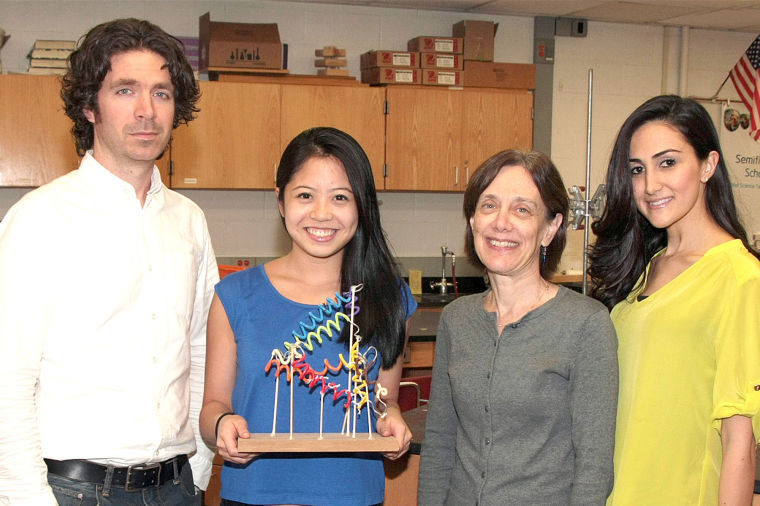Four Great Neck Public Schools seniors have been named semifinalists in the 2013 Siemens Competition in math, science and technology, one of the most prestigious student competitions in the science community. They are Luhong (Larry) Li, Clara Sava-Segal, and Terry Wei from North High School, and Lelina Chang from South High School. North High science research advisors were Alan Schorn and Dr. Marie Van Nieuwenhuizen. Dr. Carol Hersh was South’s science research advisor.
Following are excerpts from the winning students’ project abstracts or executive summaries, required parts of each entry.
Luhong (Larry) Li’s project is “Velocity Gradient in Relation to Spatial Scale of Star Forming Dense Cores in the Perseus Molecular Cloud.” Li explained his project: A star’s life begins as a dark cloud of gas and dust. When dark clouds grow to a certain size and mass, gravity forces them to collapse into star-forming dense cores. The mass and rotation rates of those dense cores are important to star formation theories and are not completely understood. To help with understanding the role of rotation in star-forming cores, Li selected sub-regions in dense cores from the Perseus Molecular Cloud with interesting velocity and density structures and calculated their velocity gradient, a measure of rotation rates when paired with the solid body rotation model.
With that, he found that there are sub-regions with sizes around 0.2 parsecs inside star-forming cores that rotate at a much faster rate than the overall defined core. Although more evidence and testing are needed, the matching of the two radius is very interesting and might provide new insights to boundaries of star-forming cores and star-formation theories.
Clara Sava-Segal’s project is “The Expression and Regulation of AqBANQUO Genes in Aquilegia.” Sava-Segal writes: Model systems of angiosperms or flowering plants are consistently being developed in order to see which gene functions are evolutionarily conserved and which ones are novel. The most studied system at this time is Arabidopsis thaliana (mustard plant), which has one whorl of petals, the organ intended to attract pollinators. Certain flowers, however, like Aquilegia (columbine), have developed multiple whorls of organs that show petal-like features, and current studies aim at explaining these changes.
In Arabidopsis thaliana, the genes that determine the development of the petals and stamens in the flowers (B-class genes) negatively regulate genes that are involved in chlorophyll production (BANQUO genes). Sava-Segal used Aquilegia to see if this mechanism existed in systems with multiple whorls of petal-like organs. She silenced the B-gene PISTILLATA in Aquilegia plants and found that the BANQUO genes were downregulated instead of being upregulated in the petals and sepals. This shows that the mechanism of chlorophyll gene suppression is not conserved across angiosperms.
Terry Wei’s project is “Comparing the Back-projection Method of Analysis with the JMA HiNet catalogue using the 2011 March 11 Event to Determine the Effectiveness of Imaging Aftershocks.” Wei explained that the Great East Japan Earthquake, on March 11, 2001, was one of the most intense earthquakes ever recorded. The aftershocks that followed the mainshock were extremely intense and were imaged by the Japan Meteorological Agency’s (JMA) HiNet Array.
Many places do not have local dense arrays such as the JMA HiNet Array and so a novel method of analysis known as back-projection, which uses a large number of long-distant stations, was applied to see if it can be used to accurately image aftershock sequences. A comparison between the catalogue produced by the JMA’s HiNet array and the generated back-projection catalogue of the March 11 event found that back-projection was able to detect all events in the desired region that were on the JMA catalogue and was also able to detect an additional 300 events.
Lelina Chang’s project is “Investigating the Role of Lymphocyte Osteopontin (OPN) in the Progression of Obesity.” Chang explained her project: According to the World Health Organization, one billion people are overweight worldwide, and at least 300 million are obese. With rising rates of obesity and obesity-induced diseases in the United States and around the world, understanding the mechanisms behind the progression of obesity and its associated complications has become a growing field. Osteopontin is a protein that has been shown to increase in obese humans and mouse models and has been suggested to play a role in the progression of obesity.
Chang noticed that male mice engineered to over-express osteopontin in their lymphocytes (immune cells) were overweight compared to male normal mice, even though they ate equal amounts of food. Her goal was to understand how the over-expression of osteopontin in lymphocytes was causing the mice to become overweight.
Chang measured levels of substances commonly tested for in obesity studies. She found that the mice that over-expressed osteopontin in their lymphocytes exhibited the same metabolic trends seen in obese mice such as increased cholesterol, insulin, and other proteins known to contribute to fat accumulation. This suggests that mice over-expressing OPN from lymphocytes are undergoing metabolic changes similar to those seen in obesity and obesity-induced diseases.
Chang also looked at gene expression and saw that OPN transgenic mice express certain genes which are associated with obesity more than regular mice and other genes less than regular mice. It is possible that the genes for which altered expression was observed may be causing the changes in metabolism seen in mice that over-express osteopontin in lymphocytes. Elucidating the role that lymphocyte osteopontin plays in the progression of obesity may be helpful in developing treatments for obese patients.



